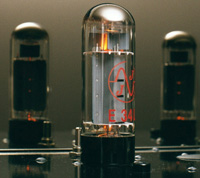
|
Home |
Amplifiers
|
Speakers |
|
Vacuum Tubes |
Education |
Support |
Contact |
Q. Why should I
buy a quality vacuum tube amplifier? A. Serious listeners
know ownership of vacuum tube equipment has nothing to do with 'nostalgia' or
'what's in style.' But just because a component is designed using tubes,
does not make it by definition a superior product. Much tube equipment
sounds rather 'soft' and 'bland' or simply does not justify its cost, in our
opinion. The primary reason to invest
in our vacuum tube amplification is superior sound quality resulting in a more
emotional involvement with the music you love. Sonic qualities such as
purity and soundstaging are characteristics primarily associated with our vacuum
tube electronics. These qualities can sometimes be found in solid-state
equipment as well, but only at much higher cost.
A. First, large, complex power
transformers supplying multiple low and high voltages at fairly high currents
are required for the power consumption requirements of the tubes. The
transformer must also have a low electrical radiation field and low current
leakage for both low mechanical and electrical noise. We have
spent a lot of time and effort in design of our power
transformers which have extremely low electrical radiation and current leakage.
They are therefore more difficult
and costly to build. Second, the
output transformers which provide electrical impedance and power matching
between the output tube(s) and the speaker is a complex device requiring hand
winding and assembly if flat, extended frequency response and maximum power
transfer is to be achieved. Our transformers are a small work of art in
their execution. Third, the chassis must be
rigid and strong to support 25+ pounds of transformers and to provide
minimal mechanical vibration transfer from the power transformer to the tubes.
Our chassis are made of thick aluminum for low electrical and magnetic noise
transfer, maximum heat dissipation, optimal finishing characteristics, and
lighter weight for lower shipping cost. Other manufacturers use much thinner plated or painted steel,
a far cheaper solution. Making a chassis from thick,
solid aluminum and finishing it beautifully is far more expensive, but provides the best overall results. Fourth, our
construction technique is such that any part of the amplifier or preamplifier
may be removed and replaced in the event of failure or damage. That means
our amplifiers will be maintainable decades from now. This requires hand
assembly, a necessarily slower, but higher quality technique. Our amplifiers
are actually less expensive than the equivalent-quality solid-state units and
the Mini
Amplifier is more compact than nearly all of them! A. They have a
sonic life of about 2500 to 8000 hours, depending on type and implementation. The end of the tube's useful sonic
life is determined when there is a loss of dynamics or rhythmic 'drive' and an
overall 'softness' of the sound. This happens very gradually and a quick change of tubes will restore the
original sound. In an average installation, it will be found advantageous to change a couple of the tubes,
usually the larger output tubes, about every three
years. By the way, nearly all the
components in our amplifiers are significantly over-specified. Our amplifier owners can feel free to
operate our amplifiers all day every day. Since 1989, we have supplied suitable,
screened
replacement tubes for all of our tube components at reasonable cost, and our Warranty
covers them for 90 days from the date of purchase.
Q. Why are tube
amplifiers expensive?
Q. How often must
the tubes be replaced?

|
Home |
Amplifiers
|
Speakers |
|
Vacuum Tubes |
Education |
Support |
Contact |